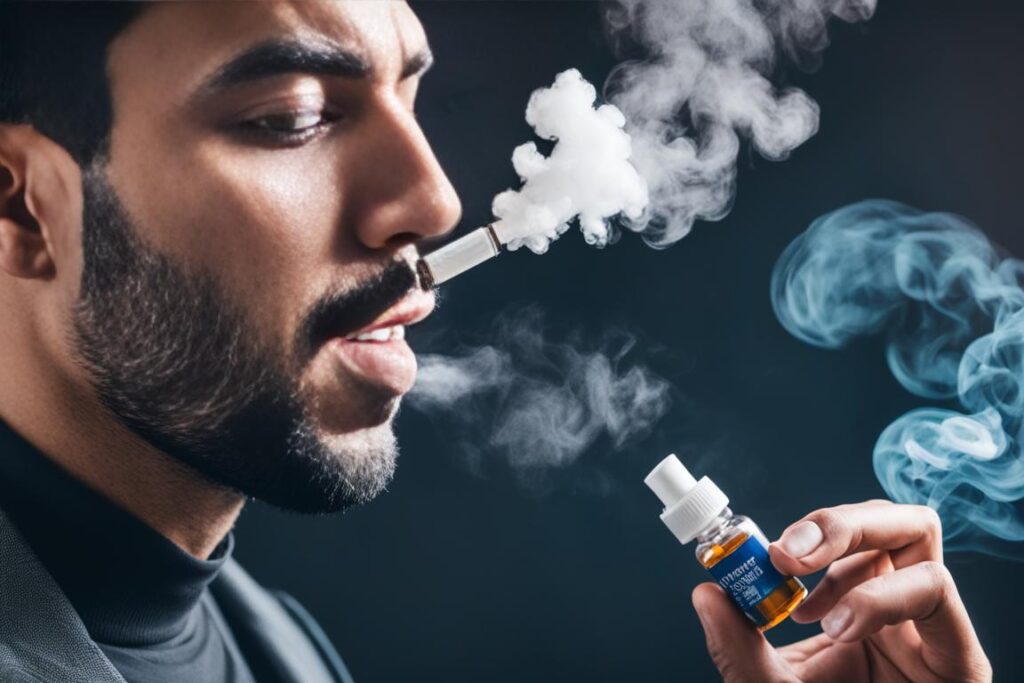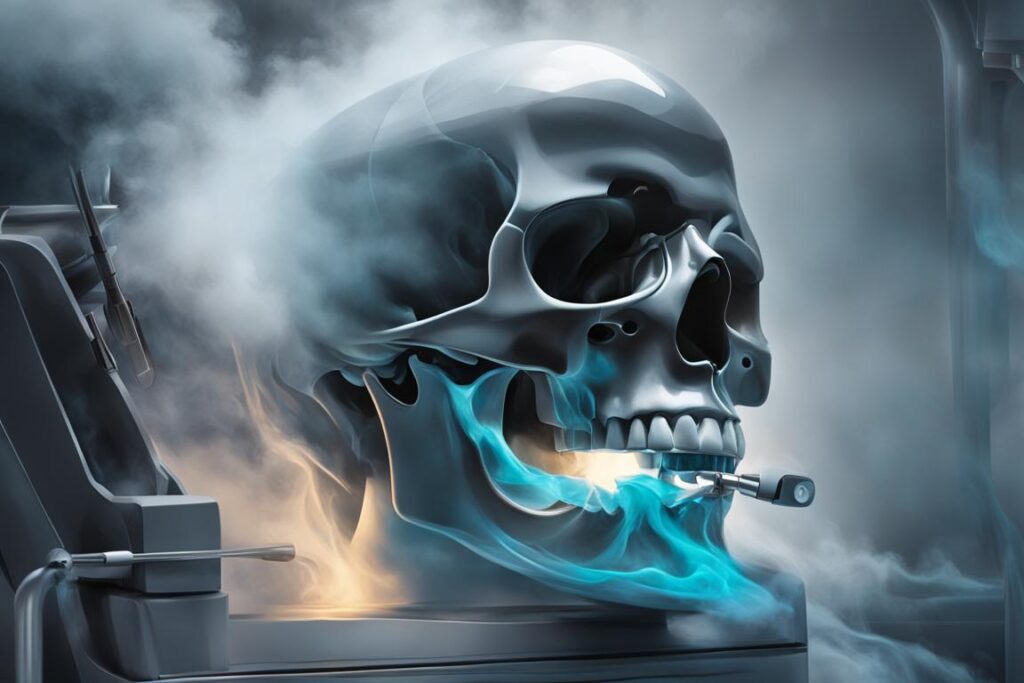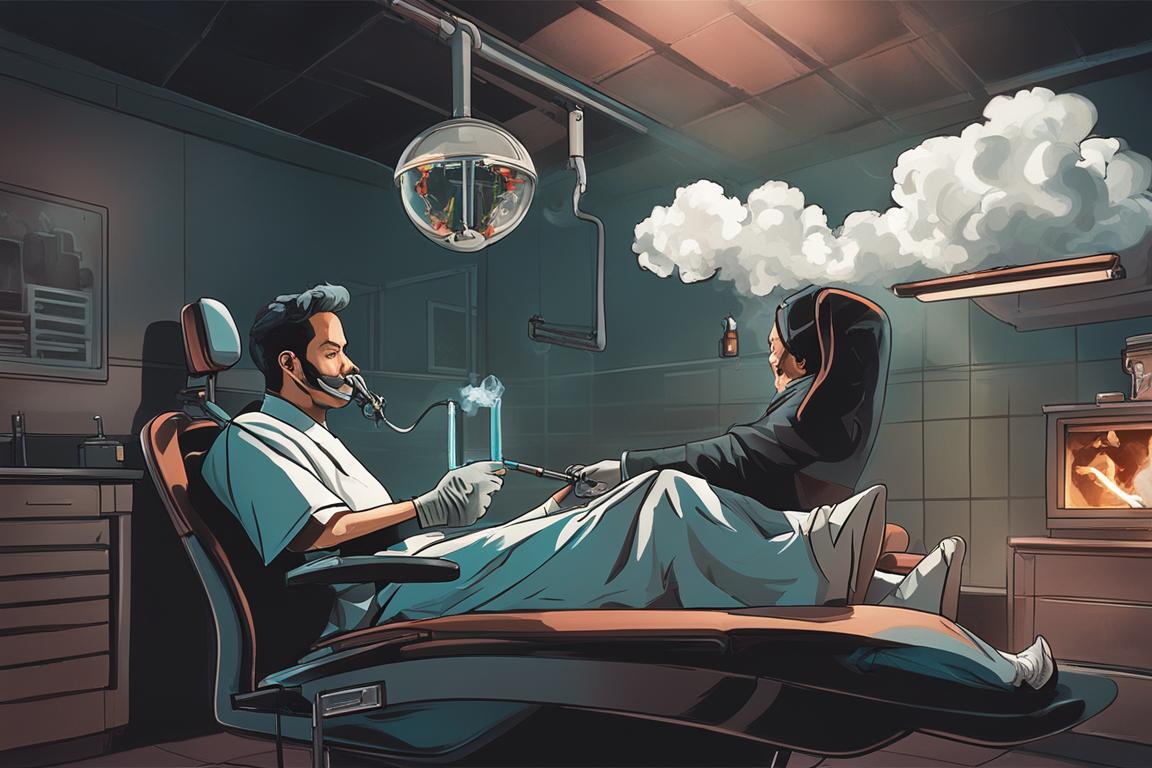If you’ve recently had a tooth extraction and you’re wondering if you can resume vaping, there are some important risks you need to be aware of. Vaping can potentially interfere with your healing process and increase the chances of complications. To make an informed decision, it’s crucial to understand these risks and take proper precautions.
When you undergo a tooth extraction, your body is in the process of healing and closing the wound left by the extracted tooth. Vaping after this procedure can disrupt this healing process and lead to various complications.
One of the main dangers of vaping after a tooth extraction is the risk of developing dry socket. This occurs when the blood clot that forms in the extraction site gets dislodged, exposing the bone and nerves underneath. It can cause severe pain and increase the risk of infection. Vaping can contribute to the formation of dry socket by creating suction and pulling the blood clot out.
In addition to dry socket, vaping after a dental procedure also increases the risk of infection. Vape devices and mouthpieces can introduce new bacteria and contaminants into your mouth, which can infect the surgical site. Sharing vape devices or not practicing proper hygiene while vaping can further increase the risk of bacterial contamination.
Furthermore, the chemicals and vaporized substances in vape juices can irritate the surgical site and slow down the healing process. Exposure to these compounds can cause inflammation, delay healing, and worsen pain and swelling. Vaping can also interfere with the efficacy of medications prescribed for your recovery after tooth extraction.
While some dentists may argue for the potential benefits of vaping in certain situations, most would advise against it immediately after a tooth extraction. It is generally recommended to wait at least 48-72 hours before resuming vaping, and to exercise caution even after that period.
By prioritizing the healing process and following the advice of your dental provider, you can ensure a smoother recovery and minimize the risks associated with vaping after a tooth extraction.
Table of Contents
Toggle- The Dangers of Dry Socket
- Increased Risk of Infection
- Effects on Healing and Inflammation
- Interference with Medications
- Arguments for Allowing Vaping After Extractions
- Recommendations from Dental Experts
- Conclusion
- FAQ
- Why can’t I vape after getting a tooth pulled?
- What are the dangers of dry socket?
- How does vaping increase the risk of infection?
- How does vaping affect healing and inflammation?
- Does vaping interfere with medications?
- Are there any arguments for allowing vaping after dental extractions?
- What are the recommendations from dental experts regarding vaping after tooth extraction?
- Is it safe to vape after a tooth extraction?
- Related posts:
Key Takeaways:
- Vaping after a tooth extraction can pose risks to your healing process and increase the chances of complications.
- The main dangers include the potential for dry socket formation, increased risk of infection, delayed healing, more pain and swelling, and interference with medications.
- Most dentists recommend waiting at least 48-72 hours before resuming vaping and using caution when doing so.
- It is important to prioritize the healing process and follow the recommendations of your dental provider.
- By understanding the risks and taking proper precautions, you can ensure a pain-free recovery after a tooth extraction.
The Dangers of Dry Socket
Dry socket is a common complication that can occur after a tooth extraction. When the blood clot at the extraction site gets dislodged too early, it exposes the bone and nerves, leading to severe pain and potential infections. Vaping can increase the risk of dry socket formation in multiple ways, including the suction action of inhaling, which can pull the clot out of the socket, and the heat and chemicals from the vapor, which can dissolve the clot before the gums have fully healed.
Risks of Dry Socket After Tooth Extraction
After tooth extraction, the socket where the tooth was removed typically forms a blood clot to protect the underlying bone and nerves during the healing process. However, this blood clot can be easily disturbed and dislodged, resulting in a condition known as dry socket. Dry socket commonly occurs within the first few days after a tooth extraction and can cause extreme pain and complications.
| Risk Factors for Dry Socket | Actions that Increase Risk |
|---|---|
| Inadequate blood clot formation | Smoking and vaping |
| Oral contraceptive use | Poor oral hygiene |
| Prolonged or difficult extractions | Drinking through a straw |
| History of dry socket | Eating hard or crunchy foods |
Why Does Vaping Increase the Risk of Dry Socket?
Vaping poses specific risks when it comes to dry socket formation. The act of inhaling vapor creates suction in the mouth, which can dislodge the blood clot from the socket. Additionally, the heat and chemicals present in vape vapor can dissolve the blood clot prematurely, preventing proper healing and leaving the extraction site vulnerable to infection.
It is important for individuals who have recently had a tooth extraction to understand the risks associated with vaping and take necessary precautions to avoid dry socket. This includes refraining from vaping for the recommended healing period and following your dentist’s instructions for post-extraction care.
Increased Risk of Infection
When it comes to vaping after a tooth extraction, one of the significant concerns is the increased risk of infection. Any open wound in the mouth is susceptible to bacterial contamination, and vaping introduces new organisms and bacteria that can hinder the healing process. Sharing vape devices or mouthpieces further exacerbates the risk of contamination.
Bacteria and contaminants from the hands and environment can easily be transferred to the surgical site each time a puff is taken, creating an environment where infection can thrive. This poses a significant danger to the healing process and increases the chances of complications.
“Vaping introduces new organisms and bacteria, increasing the risk of infection and hindering the healing process.”
It is crucial to prioritize oral hygiene and take precautions to minimize the risk of infection during the recovery process. Proper dental care, such as regular brushing, rinsing with an antimicrobial mouthwash, and following the dentist’s recommendations, can help mitigate this risk.
In conclusion, the bacterial contamination associated with vaping significantly elevates the infection risk after tooth extraction. Taking measures to prevent bacterial infiltration and practicing good oral hygiene are essential for a successful recovery process.
Precautions to Minimize Infection Risk:
- Avoid sharing vape devices or mouthpieces with others.
- Practice regular oral hygiene, including brushing and flossing.
- Rinse the mouth with an antimicrobial mouthwash as recommended by the dentist.
- Follow the dentist’s post-extraction care instructions closely.
By following these guidelines, you can reduce the risk of infection and promote a smoother healing process after a tooth extraction.
Effects on Healing and Inflammation
The process of healing after a tooth extraction is crucial for the long-term health and well-being of your oral cavity. However, vaping can have detrimental effects on this healing process, leading to delayed healing and increased inflammation.
When you vape, the chemicals, flavorings, and vaporized glycerin present in e-liquids can irritate the wound and surgical site left behind after the extraction. This irritation can further exacerbate inflammation, damaging cells and impeding the body’s natural healing abilities.
Inflammation is a necessary part of the healing process as it helps to remove debris and initiate repair processes. However, excessive inflammation can prolong healing time and contribute to discomfort such as pain and swelling, which are already commonly experienced after a tooth extraction.
Vaping can also interfere with the body’s inflammatory response, which plays a vital role in healing. The inhalation of vapor introduces additional compounds and heat to the surgical site, heightening the body’s immune response and potentially worsening inflammation. This can hinder the healing process and increase the risk of complications.
It is important to prioritize the healing process and give your body the best chance to recover fully. By refraining from vaping after a tooth extraction, you can minimize the risk of delayed healing and inflammation. Your dental professional will provide guidance on when it is safe to resume vaping, taking into account the individual factors of your extraction and oral health.
Interference with Medications
When it comes to vaping after a tooth extraction, it’s important to consider any potential interactions with medications you may be taking. Nicotine, which is present in vape juices, can interfere with the efficacy of prescribed drugs that are crucial for healing and recovery. Similar to smoking, vaping could have contraindications with many prescription medications.
To ensure your safety and optimize your healing process, it is essential to inform your dentist about all the medications you are taking, including nicotine intake. Seek professional advice from your dentist to determine whether it is safe to continue vaping after your tooth extraction.
| Medication | Interactions with Nicotine/Vaping |
|---|---|
| Prescribed antibiotics | Vaping nicotine can potentially decrease the effectiveness of antibiotics or interfere with their absorption. |
| Analgesics | Nicotine and vaping may affect the pain-relieving properties of analgesics, leading to decreased pain control. |
| Anti-inflammatory drugs | Vaping can potentially exacerbate the inflammatory response, counteracting the effects of anti-inflammatory medications. |
It’s important to follow medical advice and ensure that you don’t jeopardize your recovery by potentially undermining the effectiveness of your prescribed medications. Always consult with your dentist or healthcare professional regarding any concerns or questions about the interaction between vaping, nicotine, and your specific medications.

Arguments for Allowing Vaping After Extractions
Although most dentists advise against vaping after tooth extractions, there are potential benefits that may make it reasonable in certain situations. Some arguments in favor of allowing vaping during the healing process include:
- Potential stimulation of blood vessels: Nicotine, a common component of vape juices, has been suggested to have stimulant effects on blood vessels. This could potentially enhance blood circulation to the surgical site, aiding in the healing process.
- Comfort and distraction: For many individuals, the oral fixation and the nicotine hit provided by vaping can offer comfort and a distraction from the discomfort of recovery. This can help alleviate stress and provide a sense of relaxation during the healing period.
- Advanced vaporizer technology: The advent of newer vaping devices has led to the development of products that involve gentle puffing and produce minimal vapor. These devices reduce the risk of complications associated with vaping after tooth extraction.
It is important to note that caution should still be exercised, and it is recommended to wait at least 48-72 hours after the extraction before resuming vaping. Vape products should be used sparingly to ensure proper healing and minimize potential risks.
Remember to consult with your dental provider for personalized advice and guidance on whether vaping is suitable for your specific situation.
Recommendations from Dental Experts
Dental experts strongly caution against rushing back into vaping after a tooth extraction. To ensure proper healing and avoid potential complications, it is important to follow the guidelines and recommendations provided by your dental provider.
Waiting Period
Experts advise waiting at least 48-72 hours before resuming vaping after a tooth extraction. However, if the extraction was traumatic or more complex, it may be necessary to wait for a longer period of time. It is essential to give your mouth enough time to heal before introducing vaping back into your routine.
Vaping Technique
When you do start vaping again, it is crucial to be mindful of your technique. Take gentle and shallow inhales to minimize pressure changes in the mouth. Avoid creating suction that could dislodge the blood clot or interfere with the healing process.
Breaks and Limitations
In addition to being cautious with your inhales, it is recommended to take breaks between vaping sessions. This allows the extraction site to recover and reduces the risk of irritation and inflammation. Using caution and moderation when vaping during the recovery period is key to achieving a smooth healing process.
Oral Hygiene
Maintaining proper oral hygiene is crucial during the recovery period. Keep the extraction site clean by following your dental provider’s recommended oral care routine. This may include using prescribed oral rinses or performing gentle saltwater rinses to promote healing and minimize the risk of infection.
Follow Professional Advice
Ultimately, it is important to follow the advice of your dental provider regarding vaping after a tooth extraction. They will provide personalized recommendations based on your specific situation and ensure the best outcome for your recovery. Open communication and adherence to their guidance are essential for a successful healing process.

By following these recommendations from dental experts, you can navigate the recovery period after a tooth extraction while minimizing the potential risks associated with vaping. Prioritizing your oral health and following professional advice will help ensure a smooth and problem-free healing process.
Conclusion
Vaping after a tooth extraction can introduce risks to your dental recovery. It is crucial to prioritize the healing process and be mindful of potential complications. Most dental experts advise waiting 48-72 hours before resuming vaping, even with caution. By following the recommendations of your dental provider, you can strike a balance between the benefits of vaping and ensuring a pain-free recovery.
FAQ
Why can’t I vape after getting a tooth pulled?
Vaping after a tooth extraction can pose risks to your healing process, including the potential for dry socket formation, increased risk of infection, delayed healing, more pain and swelling, and interference with medications. It is important to understand these risks before deciding to vape.
What are the dangers of dry socket?
Dry socket is a common complication that can occur after a tooth extraction. When the blood clot at the extraction site gets dislodged too early, it exposes the bone and nerves, leading to severe pain and potential infections. Vaping can increase the risk of dry socket formation in multiple ways.
How does vaping increase the risk of infection?
Any open wound in the mouth is susceptible to bacterial infection, and vaping introduces new organisms and bacteria. Sharing vape devices or mouthpieces can further increase the risk of contamination.
How does vaping affect healing and inflammation?
The chemicals, flavorings, and vaporized glycerin in vape juices can irritate the wound and surgical site. Exposure to these compounds may cause inflammation that can damage cells and slow down the body’s natural healing abilities. Vaping can also exacerbate the body’s inflammatory response and worsen pain and swelling that are commonly experienced after a tooth extraction.
Does vaping interfere with medications?
Nicotine, present in vape juices, can interfere with the efficacy of medications prescribed for healing after a tooth extraction. It is important to inform your dentist about all your medications, including nicotine intake, and seek professional advice on whether it is safe to continue vaping after tooth extraction.
Are there any arguments for allowing vaping after dental extractions?
While most dentists discourage vaping after tooth extractions, some recognize potential benefits that could make it reasonable in certain circumstances. These arguments include the potential stimulant effects of nicotine on blood vessels, the comfort and distraction provided by the oral fixation and nicotine hit during recovery, and the use of newer devices that involve gentle puffing and minimal vapor. However, caution is still advised.
What are the recommendations from dental experts regarding vaping after tooth extraction?
Dental experts strongly caution against rushing back into vaping after a tooth extraction. They recommend waiting at least 48-72 hours before vaping again, with longer wait times for traumatic extractions. Gentle, shallow inhales should be taken, breaks between vaping sessions are advised, and keeping the extraction site clean and using recommended oral rinses are important. It is essential to follow the advice of your dental provider for the best outcome.
Is it safe to vape after a tooth extraction?
Vaping after a tooth extraction comes with definite risks, including the potential for complications like dry socket and increased infection risk. Most dental experts recommend waiting at least 48-72 hours before resuming vaping, and caution should be exercised even after this period. It is important to prioritize the healing process and follow the recommendations of your dental provider.

